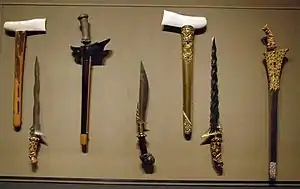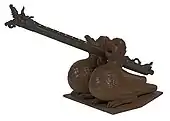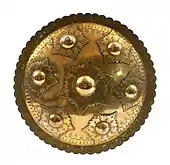| Blakas | |
|---|---|
 A Balinese Blakas, pre-1944. | |
| Type | Chopper, Cleaver, Ceremonial Knife |
| Place of origin | Indonesia (Bali) |
| Service history | |
| Used by | Balinese people |
| Specifications | |
| Blade type | Single edge, chisel grind |
| Hilt type | Water buffalo horn, wood |
| Scabbard/sheath | Wood |
Blakas or Belakas is a general name for any sort of cleaver or large knife originating from Bali, Indonesia that has a heavy rectangular blade with a straight cutting edge used for chopping.[1] The long, rounded hilt often becomes thinner at one or both ends. The blade often has a fanciful shape and encrusted motifs.[2] Sometimes it is made for ceremonial purposes, and also used in pairs with golok.[3] It is a common utensil in Balinese households and is used for kitchen chores, orchard work, and in ceremonial activities.
See also
References
- ↑ Fred B. Eiseman (2008). Traditional Balinese Tools In The Jimbaran Area, South Bali (Prabot Bali Tatamian). Fred B. Eiseman. ASIN B007HG4ZN8.
- ↑ Albert G Van Zonneveld (2002). Traditional Weapons of the Indonesian Archipelago. Koninklyk Instituut Voor Taal Land. ISBN 90-5450-004-2.
- ↑ S. Ann Dunham (2009). Surviving Against The Odds: Village Industry in Indonesia. Duke University Press. ISBN 978-0-8223-4687-6.
This article is issued from Wikipedia. The text is licensed under Creative Commons - Attribution - Sharealike. Additional terms may apply for the media files.


